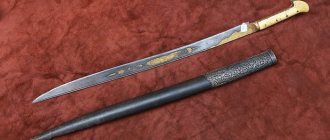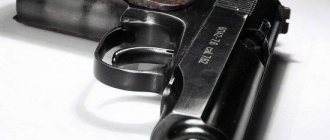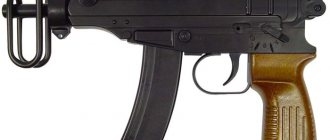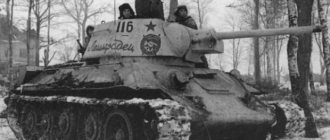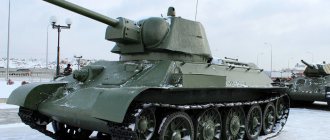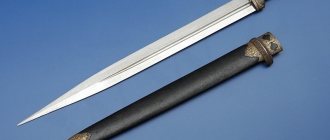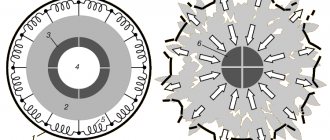Sword
And I fenced well, especially with a Scottish broadsword
Poet Lord Byron
Among the great variety of European bladed weapons, the broadsword occupies a special place. He can be called a real long-liver. Having appeared at the beginning of the 16th century, the broadsword continued to be used until the First World War, while the period of greatest popularity of this weapon is traditionally considered to be the 19th century - the era of dashing hussars and gallant cuirassiers. Broadswords are still used as ceremonial weapons, for example, they are armed with officers of the Scottish regiments of the British army. In the Soviet Union, until 1975, the so-called cadet broadsword existed as an official piece of equipment, which Navy cadets were required to wear outside the walls of their educational institutions.
The most famous type of this weapon is the Highland or Scottish broadsword - also known as the Scottish basket sword - glorified in the works of Byron and Walter Scott.
Scottish broadsword hilt
It is likely that the last time a Scottish broadsword was used in real combat was in December 1941. During Operation Archery, British Army Lieutenant Colonel John Churchill (nicknamed “Mad Jack”) went on the attack with this weapon. This officer liked to repeat that “an officer who goes into battle without a sword is armed incorrectly.” Churchill was generally a big fan of historical weapons. Judging by the facts of his biography, he always carried his officer’s broadsword with him, and during the fighting in northern France in 1940, he managed to shoot a German sergeant major with a large English bow...
Now we should define the subject of our story. A broadsword is a type of bladed bladed weapon, a cutting-stabbing type, with a straight and long blade, the dimensions of which reached 100 cm. The broadsword could have a double-sided sharpening, but usually it was one-sided or one-and-a-half. The cross-section of the broadsword blade is rhombic or lenticular; as a rule, it has no fullers. Another feature of this weapon is the massive and developed guard, which could include a shield, protective arches, a cup or a basket. The broadsword differed from the sword in its heavier and more massive blade.
The handle of cavalry broadswords often had a bend towards the blade. This made it possible to deliver more powerful chopping (almost saber) blows.
Throughout its history, the broadsword was mainly a weapon of the horseman, although, of course, it could also be used in infantry combat. The widespread use of the broadsword is associated with the emergence of large regular cavalry, as well as the gradual abandonment of massive heavy armor. This weapon also found its use in the navy - back in the 16th century, the so-called boarding broadsword appeared, which was in service almost until the end of the 19th century.
Early history of the broadsword: Mongolia, Caucasus and India
The era of the birth of the broadsword is traditionally considered to be the end of the 16th - beginning of the 17th century. However, weapons resembling it in all respects existed among the nomadic Turkic peoples back in the middle of the 6th century, except that they could not “boast” a complex and elaborate guard.
Specialized swords for slashing with a long straight single-edged blade were generally popular in the East. In mounted combat, they had an advantage over ordinary swords, since they weighed less. And this weapon was cheaper because it was easier to manufacture. Eastern broadswords often had a handle with a characteristic curve. Such weapons were very popular in the Mongol-Tatar army in the 13th and 14th centuries.
If we talk about later periods, then blades, in all respects reminiscent of broadswords, were most common in the Caucasus and the Middle East. Unlike Western European broadswords, these weapons, as a rule, had weak protection for the fighter’s hand, which most often consisted of an ordinary cross.
Unique Ottoman broadsword with a flaming blade
In northeastern India, a broadsword called Kunda or Khanda was made. It had a straight single-edged blade up to 80 cm long with some expansion towards the end, often without a pronounced tip. Moreover, like the classic European broadsword, the Kunda had a hilt with developed hand protection, which consisted of a bowl and a wide arc. Such blades were often made from damask steel, and valuable types of wood and precious metals were used for their finishing. Therefore, they were not very cheap.
In the late Middle Ages in India, another type of broadsword, the Firangi, became widespread. This Indian broadsword had a one-and-a-half edge and a complex basket hilt.
Description of the blade
Like any other bladed weapon, a broadsword consists of two main parts: a handle and a blade. The character is piercing and chopping, the blade is straight, but in some cases there is a slight bend. Also, there are not always fullers from 1 to 3. The sharpening of the blade is one-sided, but it can also be one-and-a-half, and in rare cases, double-edged.
Let's look at the structure of the sword in more detail according to the picture:
- Top.
- Rear kylon of the cross.
- Cross.
- Guard rings protruding below the cross
- Front kylon of the cross
- The strong part of the blade.
- Middle part of the blade
- The weak part of the blade and the tip.
Broadsword, indicating its parts.
Broadsword hilt
It should be discussed separately. The handle had a slightly curved shape with a developed pommel. This made it possible to conveniently carry out chopping blows. For combat samples, the handle was covered with leather. Sometimes the handle was made of valuable wood or metal. Often it was wrapped with gold or silver wire.
The Scottish broadsword had a red cloth placed inside the basket. Let's take a closer look at the handle:
- as a rule, the pommel ended with an almond-shaped or round part;
- the kylon of the rear part of the cross was a curved part going up;
- the rings of the basket guard, which protects the warrior’s hand, are located below the crosspiece;
- there is also a kylon at the front of the crosspiece.
The metal used in the manufacture of the broadsword could vary greatly. In mass production, we tried to use high-quality steel. Custom-made broadswords were forged from Damascus or damask steel. But the cost of the products was much higher.
Various options for broadsword hilts.
Broadsword of Western Europe: heir to knightly traditions
The European broadsword - like the sword - is a descendant of the long knight's sword of the Middle Ages, a heavy and versatile weapon, suitable for both mounted and foot combat. The broadsword is the brainchild of the European Modern Age, the era of the beginning of the formation of mass professional armies on the continent. The knights, of course, were very formidable and combat-ready guys, but there were few of them. Therefore, already in the middle of the 16th century, their place began to be taken by reitars - heavily armed mercenary cavalrymen. Elitism has once again given way to mass...
The creation of massive regular armies, as well as the further improvement of firearms, leads to some simplification of the warrior’s protective equipment. A similar trend was observed in relation to the weapons of an ordinary warrior.
The original weapons of the Russian cavalry of the War of 1812 - broadsword and sabers
It is believed that the Hungarian hussars were the first to use broadswords in the second half of the 16th century. For them, this weapon was an addition to the saber. Very quickly, the broadsword practically replaced the sword in Western Europe.
Here you should pay attention to one important feature. Throughout its history, the broadsword was exclusively a combat weapon, intended for the terrible whirlwind of a real fight, and not for “noble” fencing. In this regard, the broadsword can be called the antipode of the Breter sword or ceremonial saber. For its time, a broadsword on a belt was a kind of sign not of a court whip, but of a seasoned “front-line soldier” who had managed to smell gunpowder. It could be seen among the Scottish Highlanders, the “ironsides” of Lord Protector Cromwell, and subsequently among the cuirassiers of the Napoleonic Wars.
The broadsword was not very suitable for virtuoso fencing, which, as a rule, has no place in a real battle. Therefore, it is absolutely no coincidence that defenses when using this weapon were often taken with the left hand - with the help of a bracer or a small shield (the highlanders used these until the 18th century). In an individual duel against a skilled fencer, a fighter with a broadsword had little chance.
Venetian schiavona in all its glory
Further evolution of the European broadsword
The evolution of the broadsword can be traced by changes in the hilt of this weapon. The broadsword guards of the 16th century already had arcs and rings that securely covered the hand, but despite this, they were still very similar to the hilts of ordinary swords that existed during this period.
Reitar broadsword with Walloon hilt
In the 17th century, the further development of the broadsword went in several directions, forming three groups, one of which can conditionally be called general, and the other two regional:
- Walloon broadsword and haudegen;
- Scottish broadsword;
- Venetian schiavona group.
Haudegen or Mortuary Sword. This strange name is associated with a human head, the image of which was often applied to the hilt of this weapon. And since a significant part of these swords date back to the period of the English Civil War, collectors of the 19th century believed that the royalists depicted the executed King Charles I on their weapons. Later research refuted this assumption, but the gloomy name stuck...
The Walloon broadsword is most widespread in the countries of central and northern Europe. This weapon has a characteristic shield, consisting of two parts, which is connected to the pommel by arches. The rear killon of the crosspiece is bent to the tip and ends with a spherical pommel. The front killon goes into a protective bow connected to the pommel.
Modern replica of Oliver Cromwell's haudegen
The haudegen hilt did not have a crosspiece at all, but it had a well-defined basket and a protective shield. Most of these broadswords have a single-edged sharpening, although one-and-a-half and double-edged examples are found.
The Venetian schiavona had a very small distribution area; initially only the Doge's Guard was armed with this broadsword. The main features of this weapon were a pommel shaped like a cat's head, as well as a guard with S-shaped arms. The fencer's hand was protected by a basket formed by oblique arches.
Schiavona with scabbard. The “cat’s head” of the pommel and the characteristic shape of the arches are clearly visible.
Venetian group
Italian broadsword
Italian schiavones were very clearly divided into ceremonial weapons of the nobility and guards and military, functional weapons of ordinary warriors. The first was distinguished by the grace and rich decoration of the guard basket. The second was a product of mass production and was often adjusted to the hand and sharpened by the warrior who owned it. These weapons were manufactured only in the territory of Venice, and initially the name gli schiavoni referred only to the broadswords of the Venetian guards. Later it was assigned to all weapons with a similar guard structure.
Scottish broadsword, or what Rob Roy's weapon was
The Scottish broadsword is, without a doubt, the most famous representative of this group of weapons. It began to be used at the beginning of the 17th century and very soon spread throughout England and Ireland. The Scottish broadsword is often called a claymore, which is a mistake, for this is the name of the famous heavy two-handed sword of the Highlanders. True, it should be noted that in the 17th century, claymores, which were obsolete at that time, were often reforged into broadswords.
Scottish broadsword in sheath
The Scottish broadsword usually had a double-edged blade, the length of the blade was 70-80 cm, and its width was about 4 cm. The basket guard of the hilt has very wide arcs that reliably cover the fighter’s hand. The guard of the Scottish broadsword is lined with thick fabric or leather, which is also a feature of this weapon.
Schiavona
The Schiavona was even less widespread geographically than the Scottish broadsword, as it was found only in Venice. Initially, the word gli schiavoni was used to refer to the swords with which the Doge's Guard was armed; later, all swords with a basket hilt in the Venetian style began to be called this.
Schiavona
Different examples of schiavona differ significantly from each other in the level of quality and complexity of decoration: some are very simple and functional, while others are decorated with excellent chasing and brass inlay.
Statutory broadsword of European armies
In the 17th century, the development and improvement of mass professional armies continued on the European continent. One of the components of this process is the unification of weapons, which is generally completed by the beginning of the 18th century. As a result, each branch of the military receives its “own” bladed weapon. So, for example, light cavalry received sabers, and broadswords were adopted for heavy cavalry.
Dragoon broadsword, late 18th century
Regular broadswords were heavy, usually single-edged weapons with a pronounced edge, well adapted for a powerful piercing blow. They were made in huge quantities, so many copies of these weapons have survived to this day. The characteristics of statutory broadswords, as a rule, were strictly regulated.
In the second half of the 19th century, the broadsword in cavalry was gradually replaced by the saber.
Walloon swords
Researchers believe that the Western European broadsword is a weapon resulting from the transformation of a previously existing heavy cavalry sword, which was called a saddle sword, since it was usually attached to the saddle. In this regard, broadswords were initially called Walloon swords, after the name of the region of Belgium where this type of weapon was produced. Their characteristic feature was somewhat asymmetrical hilts, which reliably protected the warrior’s hand thanks to a bowl equipped with numerous arches and a transverse crosspiece.
Broadsword in the Russian Empire
The oldest surviving copy of this weapon in our country is considered to be a broadsword that belonged to Prince Skopin-Shuisky at the beginning of the 17th century. Today it is kept in the Moscow Historical Museum. This broadsword has a straight double-edged blade 86 cm long and a hilt with a simple crosspiece, the arms of which deviate towards the tip. The handle of the weapon is curved, it forms a kind of support for the hand. The broadsword is richly decorated with gold and silver embossing and precious stones. The scabbard of the weapon is made in a similar style.
At the beginning of the 17th century, Skopin-Shuisky’s broadsword was rather a curious curiosity for Russia - today historians believe that it never saw action in a real battle. Broadswords became truly widespread weapons for the Russian army only during the reign of Peter I - only formed dragoon regiments received them. And in the 30s of the 18th century, broadswords became the main melee weapons of Russian cuirassiers. By the middle of the same century, Russian broadswords became single-edged. By the end of the 18th century, the Russian army already had army, dragoon, soldier, guards and officer broadswords in service.
Broadsword, Russia, Zlatoust, mid-19th century
At the beginning of the 19th century, the broadswords of the Russian army were unified and somewhat simplified. They remained in service with cuirassiers until 1881, after which they were used only as ceremonial weapons.
Cadet naval broadsword, model 1940
Throughout its history, the broadsword was not exclusively a land weapon; very quickly its powerful potential was seen in the navy. Already in the 16th century, the so-called boarding broadsword appeared, which was used during battles on ship decks. This weapon had a powerful blade up to 80 cm long, which could not only hit the enemy, but also cut a rope or cut through a wooden door. A distinctive feature of the boarding broadsword was a massive shell-shaped guard, which, if necessary, could be used to hit an enemy in the jaw.
Over the centuries, the boarding broadsword was so popular that it is still part of the dress uniform of military sailors in several countries.
In 1856, broadswords replaced cutlasses and became the official weapon of Russian sailors. Two years later, midshipmen were also armed with them. Midshipmen and officers of the Russian fleet wore a broadsword as part of their ceremonial uniform until 1917.
In the Soviet Union, they decided to revive a similar tradition, and in 1940, the broadsword was introduced as equipment for cadets of naval schools. The naval cadet broadsword was required to be worn in all cases when the cadet was away from an educational institution or ship. In 1958, broadswords were reserved only for assistants at the banner, as well as unit duty officers and orderlies. They say this happened because cadet broadswords began to be increasingly used in street fights. In 1975, the broadsword as an element of equipment in the Soviet fleet was completely abolished.
